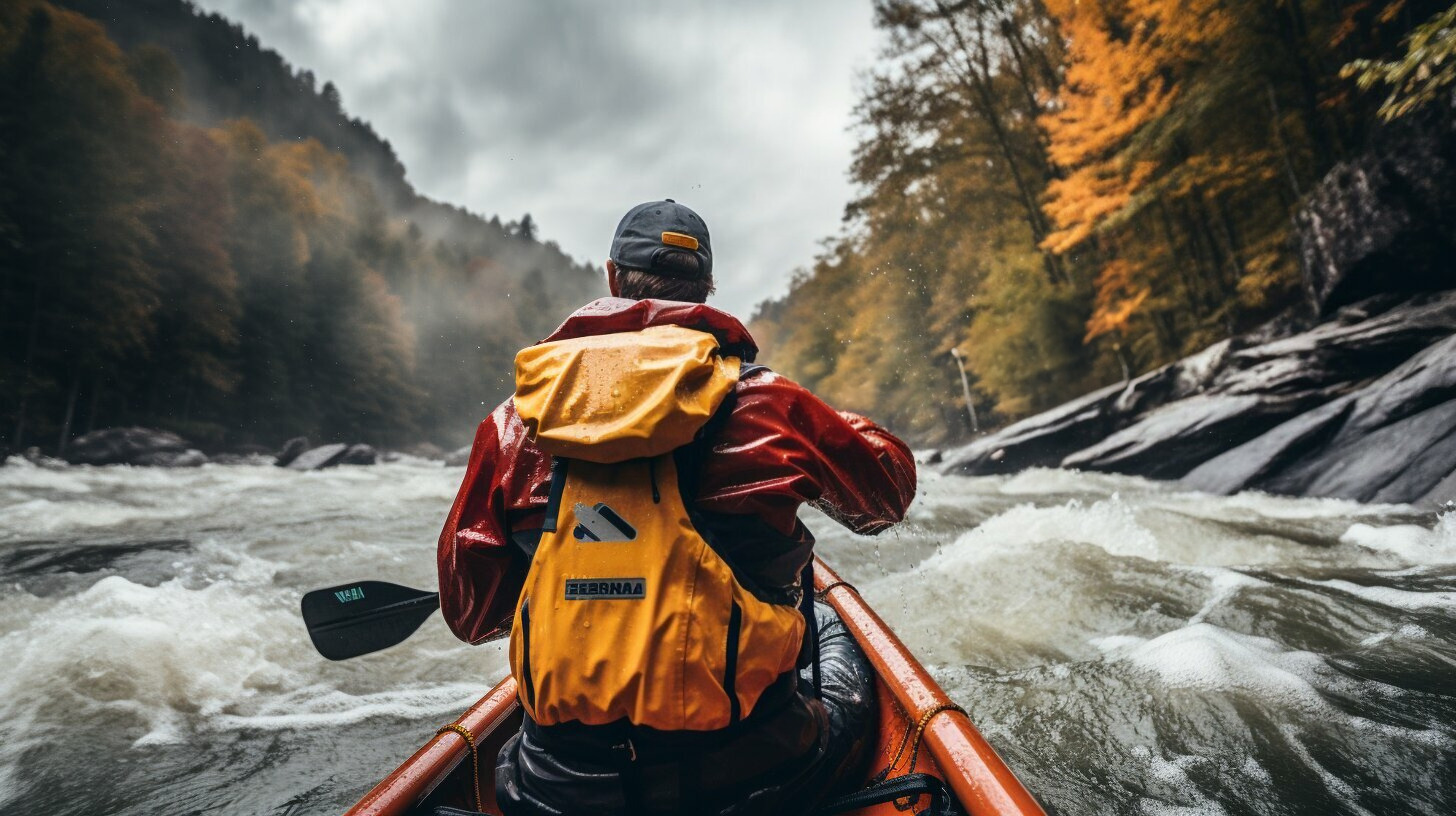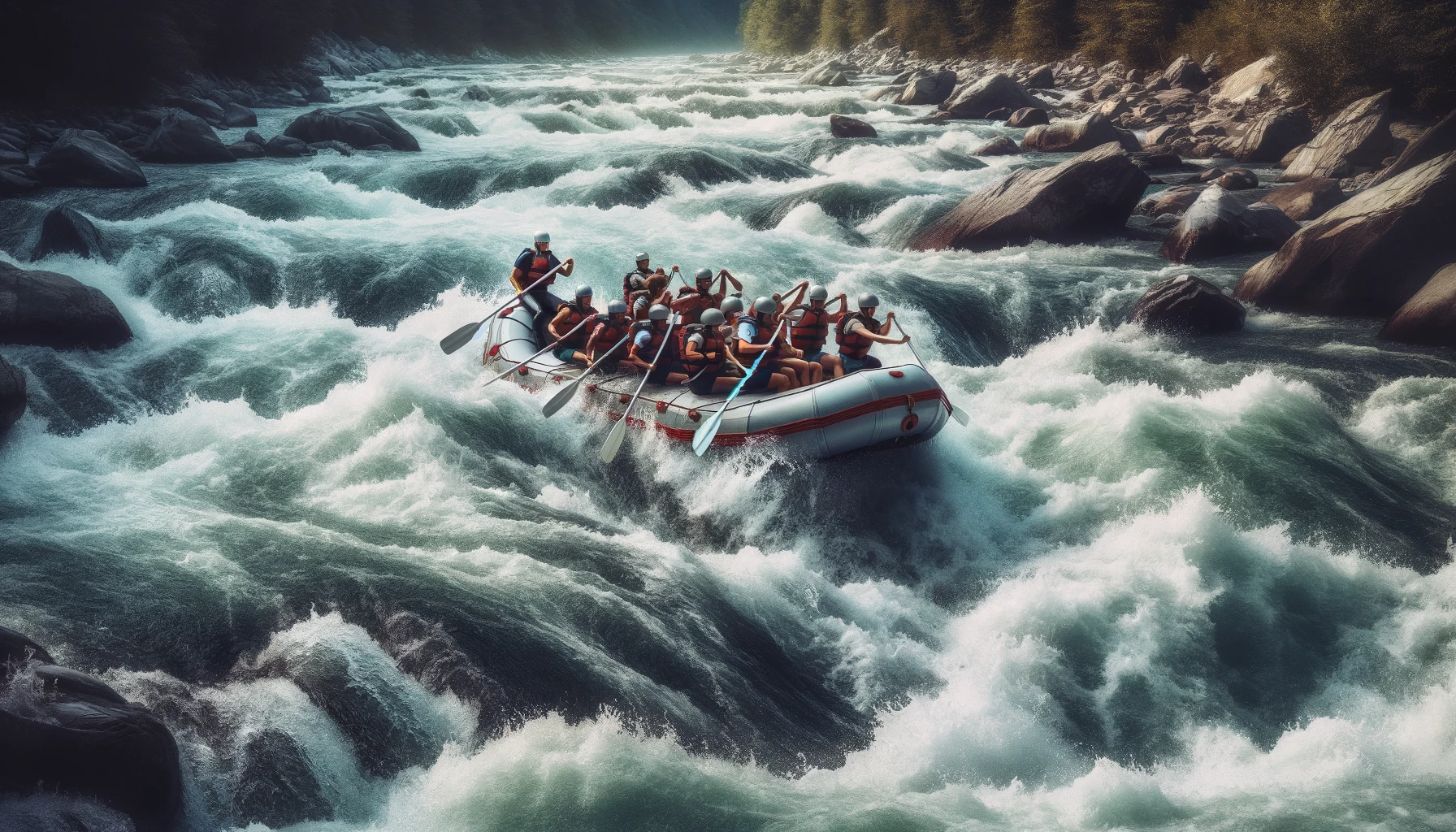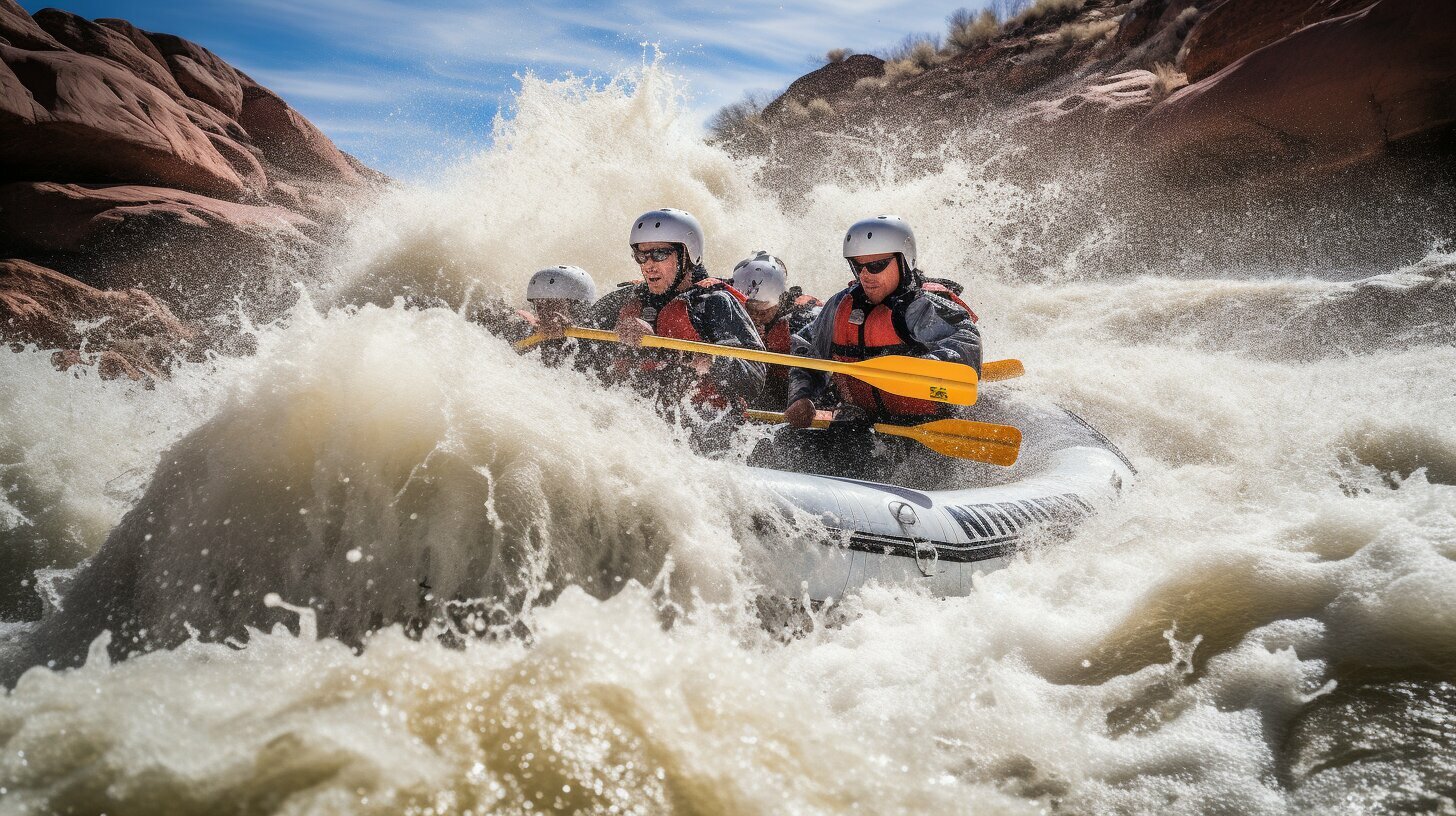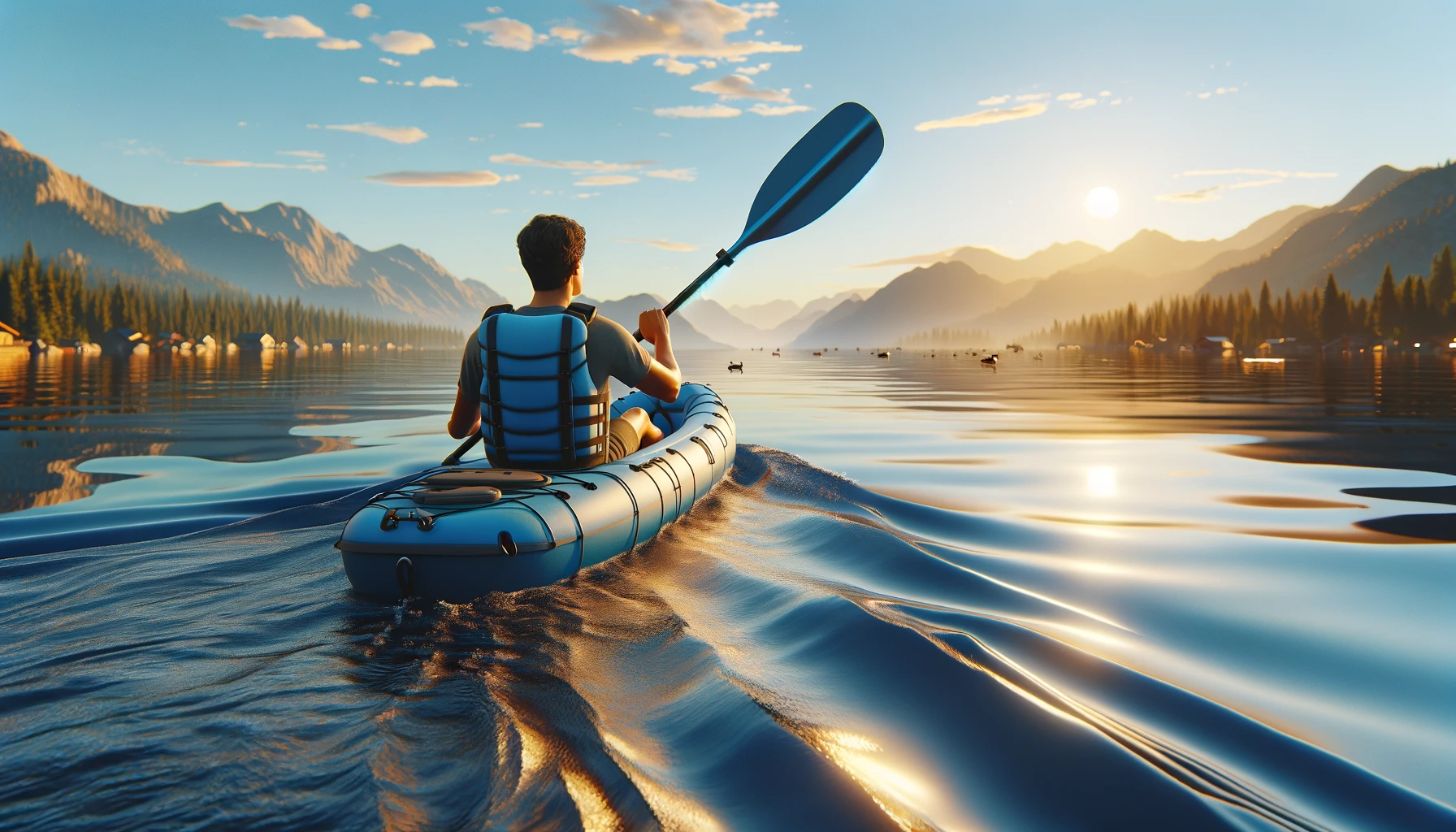Are you ready for an adrenaline rush and a challenge like no other? Look no further than canoeing in rapids – a thrilling outdoor adventure that combines the beauty of nature with the excitement of navigating challenging water currents. Whether you’re a seasoned pro or a beginner looking to try your hand at white water canoeing, this comprehensive guide has everything you need to master the art of rapids exploration.
In this guide, we’ll cover the basics of canoeing in rapids, including understanding water currents, essential gear, safety measures, and techniques for maneuvering through white water. We’ll also provide tips on how to build strength and endurance for this demanding sport, how to plan your canoeing trip, and how to respect the environment and follow proper etiquette. Plus, we’ll explore advanced techniques for experienced canoeists and highlight popular rapids destinations in the United States.
Key Takeaways
- Canoeing in rapids is an exciting water sport that combines challenging water currents with beautiful natural scenery.
- Whether you’re a beginner or an experienced paddler, understanding the basics of rapids exploration is crucial for safety and enjoyment.
- Proper gear, safety measures, and paddling techniques are essential for mastering the art of white water canoeing.
- Building strength and endurance through training is key to conquering even the most challenging rapids.
- Respecting the environment and following proper canoeing etiquette are important for preserving natural habitats and ensuring a safe and enjoyable experience for all.
Understanding Canoeing in Rapids
Before embarking on the exciting adventure of canoeing in rapids, it’s essential to understand the basics of rapids exploration. Canoeing in rapids is a popular water sport that offers a thrilling and challenging experience to adventure enthusiasts. Rapids are classified based on the intensity of their water currents, with Class I being the mildest and Class VI being the most challenging.
When canoeing in rapids, you’ll encounter a range of water currents that can be testing. Rapids have various features that make them unique, such as waves, eddies, holes, and currents. Eddies are circular currents that can be used to navigate and rest while making your way down the rapids, while waves can pose a threat to your canoe and require careful maneuvering. Understanding these features will help you navigate through the rapids safely and with ease.
Disclosure: When you buy through links on our site, we may earn an affiliate commission.
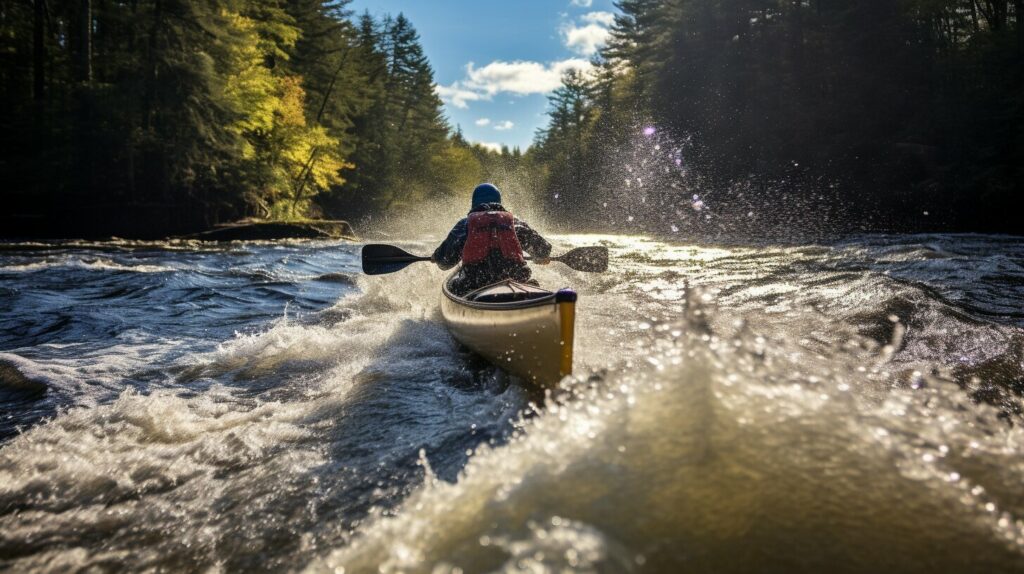
To fully enjoy the rapids exploration, you’ll need to have basic canoeing skills and the necessary equipment. Your canoe should be stable, durable, and maneuverable when navigating in challenging water currents. Your paddle should be the appropriate size, shape, and weight to provide the necessary propulsion and control. In addition to this, you’ll need to wear the right clothing, including a wetsuit, helmet, and life jacket.
Overall, the key to mastering canoeing in rapids is to practice and hone your skills constantly. The more you paddle, the more confident and comfortable you’ll become when navigating rapids.
Types of Canoes for Rapids Exploration
Canoeing in rapids requires a specific type of canoe that is designed for maneuverability and durability. There are two primary types of canoes used for rapids exploration:
- Creek boats: these canoes are designed for technical water and are shorter, wider, and more maneuverable than other canoes. They are perfect for steep, narrow, and rocky drops.
- Playboats: these canoes are designed for performing tricks and maneuvers in rapids. They are shorter and have more volume, which makes them ideal for spinning, stalling, and flipping.
Before selecting a canoe, it’s important to consider your skill level, the type of rapids you’ll be paddling, and your personal preferences. Choosing the right canoe can make a significant difference in your rapids exploration experience.
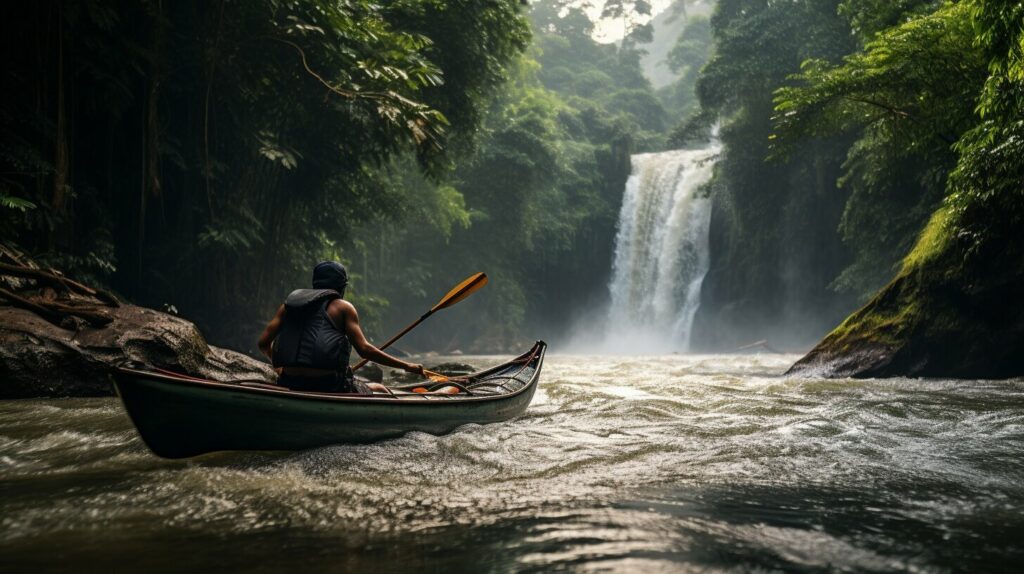
Canoeing Rapids Gear
Canoeing in rapids is an exciting outdoor adventure that requires the right gear for a safe and enjoyable experience. Whether you’re a beginner or an experienced paddler, having the right equipment is essential.
The most important piece of gear for canoeing in rapids is a paddle. Paddles come in different materials, including wood, aluminum, and composite. Choose one that is lightweight and durable, with a comfortable grip for extended paddling.
Life jackets are another essential gear for rapids canoeing. It is crucial to wear one that fits snugly, with adjustable straps and buckles. Look for life jackets that offer excellent buoyancy and are approved by the US Coast Guard.
Helmets are also essential gear for canoeing in rapids, especially in extreme canoeing. Look for helmets designed for paddle sports that fit snugly and offer excellent protection to the head and temples.
In addition to traditional gear, specialized equipment is available for rapids exploration, such as spray decks, throw ropes, and float bags. Spray decks protect the paddler and the canoe from water, while throw ropes and float bags help to stabilize the canoe in challenging water currents.
When selecting gear for rapids canoeing, it’s important to consider the type of rapids you’ll be exploring, the weather conditions, and your experience level. Quality gear is an investment that ensures your safety and enhances your adventure.
Safety Measures for Rapids Canoeing
Canoeing in rapids can be an exciting and challenging water sport, but safety should always come first. Whether you are an experienced paddler or a beginner, it is important to take the necessary steps to stay safe on the water. Here are some essential safety measures to consider before and during your rapids canoeing journey:
Fast-moving water currents can quickly overpower boats and paddlers. A capsized canoe filled with water weighs over 1,000 pounds (454 kilograms) and can pin passengers underwater or against rocks, potentially leading to serious injury or drowning.
- Proper Training: Before venturing into rapids, it is crucial to receive proper training from a qualified instructor. This includes learning the necessary paddling techniques, how to read the water, and how to rescue yourself and others.
- Assess Water Conditions: Always check the water conditions before entering the rapids. Water levels can change quickly, and rapids can become more dangerous due to heavy rain or other factors. Avoid paddling in rapids that are above your skill level or too hazardous.
- Wear Proper Safety Gear: To stay safe while paddling through the rapids, it is essential to wear proper safety gear. This includes a life jacket, helmet, and specialized gear designed for rapids exploration. Make sure that your gear fits properly and is in good condition.
- Create an Emergency Plan: In case of an emergency, it is important to have a plan in place. Make sure that everyone in your group knows what to do in case of an emergency. Consider carrying a communication device such as a whistle, flare, or satellite phone.
By following these safety measures, you can minimize the risks of canoeing in rapids and enjoy a safe and thrilling water sports experience.
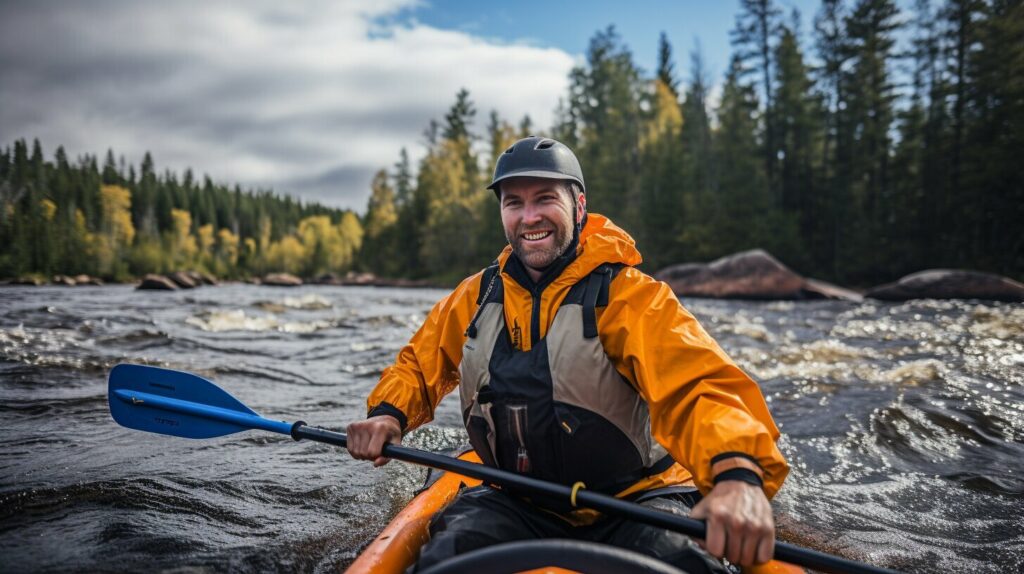
Remember to always prioritize safety when engaging in extreme canoeing or any water sports activity.
Techniques for Maneuvering in Rapids
Canoeing in rapids requires a set of specialized techniques to navigate through the challenging water currents. White water canoeing is a type of paddle sport that requires a certain level of skill, technique, and experience. In this section, we will introduce you to some basic techniques for maneuvering in rapids and handling obstacles in your path.
Eddy Turns
An eddy turn involves paddling into an eddy, which is a section of water that is moving in the opposite direction of the main current. This technique allows you to rest and reposition your canoe before re-engaging with the rapids.
To make an eddy turn, paddle towards the eddy and enter it at an angle, using a combination of forward and backward strokes to adjust the angle of your canoe. Once in the eddy, use a few strokes to turn your canoe around and then paddle out of the eddy and back into the main current.
Ferries
Ferries are used to cross the river from one side to the other, while still maintaining control of the canoe. This technique involves angling the canoe upstream and paddling at an angle across the river.
To make a ferry, paddle upstream until you reach the desired angle, then use a combination of forward and backward strokes to regulate your speed and maintain your position in the current.
Handling Obstacles
When navigating in rapids, obstacles such as rocks and waves can present a challenge for even the most skilled paddlers. To handle these obstacles, you must learn to read the water and make decisions quickly.
Use a combination of forward and backward strokes to adjust your canoe’s position, avoid rocks and waves, and maintain control through the rapids. Keep your paddle close to the water and be ready to adjust your technique and paddle strokes as needed.
Remember, practice makes perfect. Start with smaller rapids and gradually work your way up to more challenging water currents as you gain experience and confidence in your paddling skills.

Master the Art of White Water Canoeing
Canoeing in rapids can be a physically demanding experience. To master the art of white water canoeing, it’s essential to build your strength, endurance, and overall fitness level. Here are some exercises and training methods to help prepare you for the adrenalin rush of rapids exploration.
- Cardiovascular Training: Engage in activities like running, cycling, or swimming to strengthen your heart and lungs. Aim for at least 30 minutes of moderate to high-intensity cardiovascular exercise three to four times per week.
- Strength Training: Focus on building your upper body and core strength, as canoeing in rapids requires significant upper body engagement. Incorporate exercises like push-ups, pull-ups, and planks into your routine. Resistance training with weights or resistance bands can also be effective.
- Breath Control: Practice holding your breath for several seconds while engaging in cardio or strength training activities. This simulates the breathing patterns needed for rapids exploration.
- Balance and Stability: Work on improving your balance and stability to help maintain control of your canoe in challenging water conditions. Exercises like yoga, Pilates, and balance board training can be useful.
Remember to consult with a healthcare professional before starting any new exercise program. Be consistent in your training, and gradually increase the intensity and duration of your workouts as your fitness level improves.
Planning Your Canoeing Trip
So, you’re ready to embark on a thrilling outdoor adventure and explore the world of canoeing in rapids? Before you hit the water, it’s important to plan your canoeing trip carefully. This will ensure that you have an enjoyable trip that is safe and well-prepared.
The first step in planning your canoeing trip is to choose the right river. Consider your experience level and what type of rapids you want to explore. Research different rivers and their rapids classifications to determine which one is right for you.
Once you’ve chosen your river, assess the water levels and take note of any potential hazards you may encounter on your journey. Ensure that you have the necessary equipment and gear, including a reliable canoe, paddles, life jackets, helmets, and specialized gear designed to withstand the challenging water currents.
It’s also important to create an emergency plan. Identify exit points along your route and familiarize yourself with the surrounding wilderness. Be sure to bring a first aid kit and know basic first aid skills.
Canoeing in rapids is an outdoor adventure that requires careful planning and preparation. With the right planning, equipment, and safety measures in place, you can safely and confidently explore the exciting world of water sports and outdoor adventure.
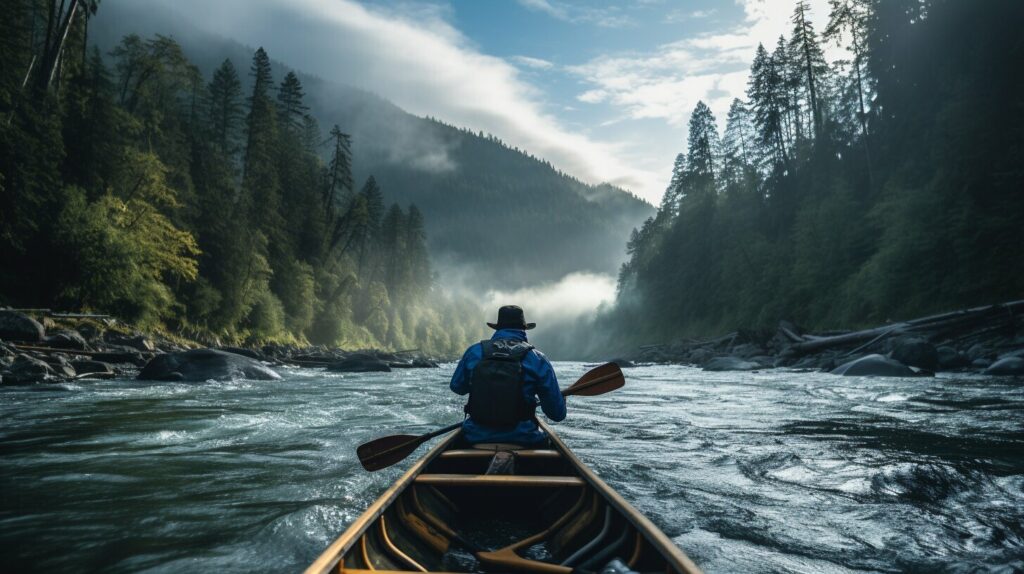
Preservation of Natural Resources
As a responsible canoeist, it is important to follow proper etiquette and minimize your impact on the environment while engaging in water sports. Here are some key points to keep in mind:
Canoeing Etiquette
- Always yield to downstream traffic and give way to swimmers and fishermen.
- Avoid littering and dispose of all trash in designated areas.
- When passing other canoes, move to the center of the river and maintain a safe distance.
- Respect private property and do not trespass on landowners’ property.
- Keep noise levels to a minimum to avoid disturbing wildlife and other canoeists.
Environmental Considerations
Canoeing in rapids allows us to connect with nature and the beautiful environment that surrounds us. To ensure the preservation of these natural resources, here are some essential environmental considerations:
- Minimize your impact on the environment by using biodegradable soaps and detergents.
- Take care not to disturb wildlife or damage vegetation.
- Support conservation efforts by volunteering for river clean-up initiatives or donating to environmental organizations.
- Learn about the flora and fauna in the area you are canoeing in and respect their natural habitat.
By following proper canoeing etiquette and minimizing our impact on the environment, we can contribute to the preservation of our natural resources and ensure the enjoyment of canoeing in rapids for generations to come.
Challenges of Extreme Canoeing
For those seeking to test their skills and push their limits, advanced techniques and challenges in rapids canoeing offer an exciting opportunity for extreme adventurists. White water canoeing, also known as extreme canoeing, is one such challenge that demands exceptional skills in navigating through the most difficult rapids and whitewater.
The art of extreme canoeing requires extensive experience in paddling and a comprehensive understanding of water currents. The experience of tackling higher-class rapids, dealing with larger waves and steep drops, and maneuvering through intricate water channels is unique and unmatched.
To master this thrilling adventure, you must have expert knowledge of the various paddling techniques, including eddy turns, peeling in and out, low and high braces, and surfing the waves. These techniques require a high level of physical strength, endurance, and mental toughness, making it a challenging yet rewarding opportunity for thrill-seekers.
Your expert skills and experience in canoeing in rapids will come in handy when you venture out to face the advanced techniques and challenges offered in extreme canoeing. You must always prioritize safety and follow the necessary precautions to ensure a safe and enjoyable adventure.
“When you’re dealing with complicated and ever-changing water currents, you must have a deep-rooted understanding of the river and the various techniques necessary to tackle it. Extreme canoeing is a unique and thrilling adventure that demands not only physical strength and endurance but also mental toughness and a passion for challenging the impossible.”
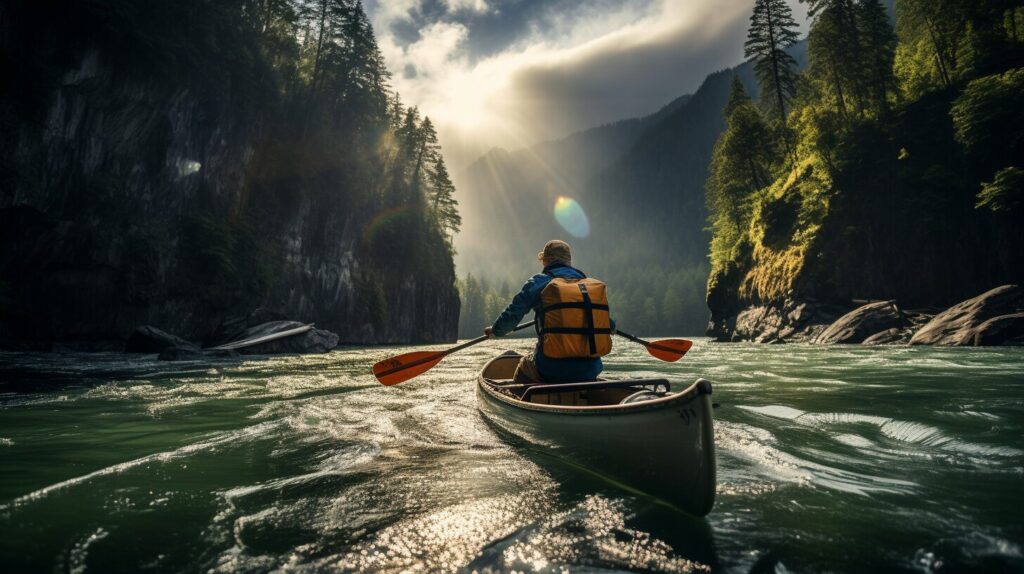
United States Rapids Destinations
Ready to hit the water? The United States boasts an array of stunning rapids destinations for adventure seekers to explore. From the wild, untamed rivers of Alaska to the breathtaking canyons of Utah, there is no shortage of epic canoeing in rapids experiences to be had.
To help you plan your next outdoor adventure, we’ve compiled a list of some of the most popular rapids destinations in the country:
| Location | Best Time to Go | Difficulty Level |
|---|---|---|
| Colorado River | May-September | Intermediate to Advanced |
| Youghiogheny River | April-October | Intermediate to Advanced |
| Chattooga River | March-June | Intermediate to Advanced |
| Ocoee River | May-September | Intermediate to Advanced |
| Arkansas River | May-September | Beginner to Advanced |
No matter your skill level, there is a rapids destination out there for you. Whether you’re a seasoned pro looking for an extreme challenge or a novice seeking a scenic river cruise, there’s no shortage of outdoor adventure to be had in the United States.
So what are you waiting for? Grab your paddle, strap on your life jacket, and experience the rush of canoeing in rapids in one of these spectacular destinations.
Conclusion
As this guide demonstrates, canoeing through rapids offers an incredible adventure for paddlers seeking to test their skills. When venturing into fast-moving waters, preparation and precaution are key. Train thoroughly, choose rivers suited to your ability, and always make safety the top priority. Respect the power of the currents, but don’t be intimidated. With practice, you’ll gain proficiency and confidence.
Remember that the rivers belong to everyone. Follow leave-no-trace ethics so that future generations can enjoy the same unspoiled beauty. Help preserve these precious waterways by supporting conservation efforts.
The rapids beckon the brave, but tread carefully. Thrill in the ride, but don’t underestimate the risks. With the proper mindset and precautions, you’re sure to have an awesome time riding the waves. Just take it one stroke at a time, be patient with yourself, and have fun out there! The journey itself is the real reward.
FAQ
Q: What are the different types of rapids?
A: Rapids can be classified into different classes based on their difficulty level. The scale ranges from Class I (easy) to Class VI (extremely difficult and dangerous). Each class represents a different level of water current strength, obstacles, and technical skill required to navigate.
Q: What equipment do I need for canoeing in rapids?
A: Essential gear for canoeing in rapids includes a sturdy canoe, paddles, life jackets, helmets, and specialized gear designed to withstand the challenging water currents. It is important to have reliable equipment to ensure your safety and enjoyment on the water.
Q: How can I ensure safety while canoeing in rapids?
A: Safety should always be a priority when canoeing in rapids. Some safety measures to consider include proper training, assessing water conditions, wearing appropriate safety gear, and creating an emergency plan. It is recommended to paddle with a group or experienced guides for added safety.
Q: What techniques should I learn to navigate rapids?
A: Successfully navigating rapids requires specific paddling techniques. Some techniques to learn include eddy turns, ferries, and how to navigate obstacles like rocks and waves. Taking lessons or joining a paddling club can help you develop these skills.
Q: How can I build strength and endurance for canoeing in rapids?
A: Building strength and endurance is important for canoeing in rapids. Regular exercise, including core and upper body workouts, can help improve your paddling abilities. Incorporating cardio exercises, such as swimming and rowing, can also increase your endurance levels.
Q: How do I plan a canoeing trip in rapids?
A: Planning your canoeing trip involves choosing the right river, assessing water levels, and preparing for potential challenges. Researching the river conditions, weather forecasts, and obtaining the necessary permits are crucial steps in ensuring a safe and enjoyable trip.
Q: What should I keep in mind regarding canoeing etiquette and the environment?
A: It is important to follow proper canoeing etiquette and minimize your impact on the environment. This includes respecting other paddlers, avoiding littering, and staying on designated waterways. Being mindful of wildlife and practicing leave-no-trace principles will help preserve the natural beauty of the surroundings.
Q: What are some advanced techniques and challenges in canoeing in rapids?
A: For experienced canoeists, advanced techniques such as surfing, playboating, and running higher-class rapids provide new challenges and opportunities for skill progression. These techniques require advanced paddling skills, experience, and a thorough understanding of the rapids’ dynamics.
Q: What are some popular rapids destinations in the United States?
A: The United States offers a variety of thrilling rapids destinations. Some popular locations for canoeing in rapids include Colorado’s Arkansas River, California’s American River, Oregon’s Rogue River, and West Virginia’s Gauley River. Each destination offers unique rapids and breathtaking scenery for unforgettable adventures.

